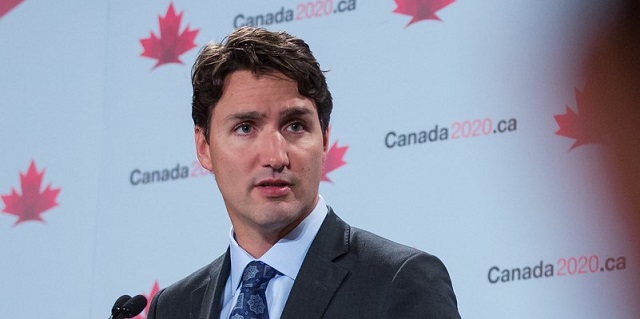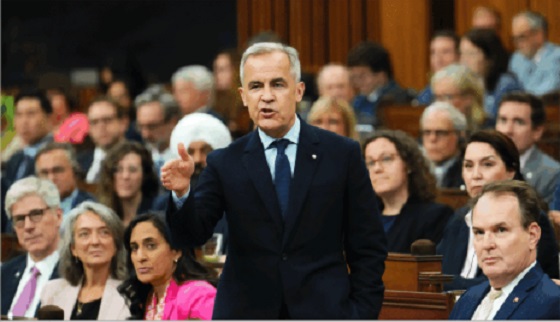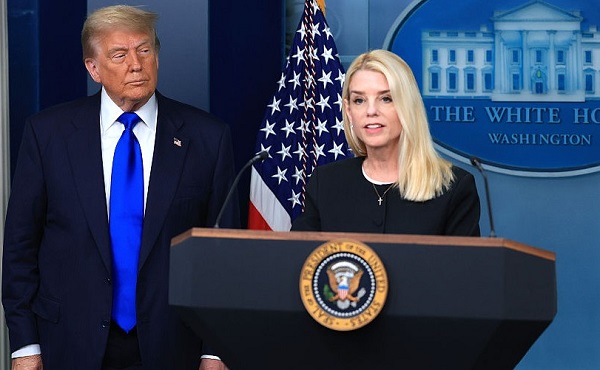Censorship Industrial Complex
Canada’s New Greenwashing Rules Could Hamper Climate Action – Grady Semmens

From Energy Now
By Grady Semmens
Also added to the mix was the ability for private citizens to lodge complaints with the Competition Bureau (starting June 20, 2025) and placing the onus on companies to prove their claims – effectively making defendants guilty of greenwashing until they can prove their information is valid.
The Government of Canada’s new rules to crack down on greenwashing will likely hamper new energy projects, including those designed to cut greenhouse gas emissions, according to experts who say they pose significant legal risk and create uncertainty for how industries across the country can communicate their plans for reaching net-zero emissions by 2050.
The legislation came into effect on June 20 as part of an omnibus package of economic policies known as Bill C-59. The package contained long-awaited tax credits for carbon capture and storage (CCS) development, sparking positive investment decisions for several new CCS projects over the summer. However, C-59 also included significant amendments to the Competition Act that require companies to more fully substantiate statements about their management of environmental and social issues – with a particular focus on claims related to climate change activity.
The crux of the concern about the anti-greenwashing laws lies in the call for companies to use an ‘internationally recognized methodology’ to report on business interests such as their decarbonization efforts. The government failed to provide guidance for what methodologies meet this standard. At the same time, massive penalties (up to three per cent of a firm’s annual gross global revenues) were introduced for companies found to be making misleading claims. Also added to the mix was the ability for private citizens to lodge complaints with the Competition Bureau (starting June 20, 2025) and placing the onus on companies to prove their claims – effectively making defendants guilty of greenwashing until they can prove their information is valid.
Response to the amendments by Canada’s energy sector was swift and dramatic. Almost immediately, the Pathways Alliance – a partnership of Canada’s largest oil sands producers that are pursuing one of the world’s largest CCS projects – gutted its website and its social media channels have gone quiet. Many energy, mining and other resource-based companies have followed suit, resulting it what some are now calling a ‘greenhushing’ that goes counter to years of admirable progress in corporate transparency and reporting on the management of environmental, social and governance (ESG) issues.
“The federal government implementing a law, without consultation, which intrinsically infringes on the ability to participate in open discussions on some of the most important issues facing the country today should be a serious concern for all Canadians,” says Lisa Baiton, president and CEO of the Canadian Association of Petroleum Producers.
Looking beyond its impact on public discourse, Baiton says the legislation also creates new roadblocks for developing critical infrastructure to help meet Canada’s climate change commitments.
“The federal government’s approach to these amendments has introduced a new level of complexity and risk for those looking to invest in Canada. The amendments to the Competition Act will make it more difficult for proponents to speak to Canadians and gain public support for their projects, particularly for those focused on reducing emissions.”
One of the country’s top environmental lawyers agrees, adding that Competition Bureau rules apply far beyond websites and sustainability reports, also encompassing the detailed plans and evidence required in regulatory applications for projects.
“Canadian regulatory processes are already protracted, and I think there will be more delays and complications for project approvals as environmental impact assessments will face an additional layer of scrutiny,” said Conor Chell, a partner and national leader of ESG legal risk and disclosure with KPMG, at a recent seminar on the impacts of C-59 on Canadian industry.
The Competition Bureau was gathering public feedback until September 27 on the new greenwashing provisions that it says will be used to provide further guidance for how the rules will be enforced. Industry players hope the consultation will result in greater clarity on what methodologies for environmental reporting the government prefers, along with details on how the bureau’s complaints tribunal will determine which complaints are in the public interest to investigate.
“Companies face a high risk of being unfairly and unnecessarily targeted and pulled into long, drawn out legal proceedings in defence of reasonable statements. Without clear guidance as to how the Competition Bureau plans to handle such frivolous and vexatious claims, this will have a chilling effect on companies’ disclosure and participation in climate and environmental policy discussions,” Baiton wrote in CAPP’s Sept. 5 feedback submission.
In the meantime, Canadian companies are figuring out how to continue reporting on their ESG performance without placing themselves at undue risk of legal action. In its latest corporate social responsibility report published earlier this month, Cenovus Energy chose to omit information on greenhouse gas emissions and other environmental subjects, while continuing to report on topics including workplace safety, engagement with Indigenous communities, and its progress on meeting equity, diversity and inclusion targets in its workforce.
“Given this uncertainty, we made the difficult decision to defer publication of information about our recent environmental performance and plans. I’d like to be very clear that this does not change our commitment to advancing our environmental work. We firmly stand by the actions we’re taking, the accuracy of our reporting and the information we’ve shared to date about our environmental performance. And, to the extent the Competition Bureau can provide clarity through specific guidance about how these changes to the Competition Act will be interpreted and applied, that will help guide our future communications about the environmental work we are doing,” Cenovus’ CEO Jon McKenzie states in his opening message to the report.
With anti-greenwashing regulations being adopted and/or strengthened in many countries, KPMG’s Conor Chell recommends companies revisit their targets and performance metrics for key environmental issues to ensure they are realistic and are backed up by accurate and consistent data.
“Canada now has some of the strongest anti-greenwashing legislation, but it is something that is growing globally, and companies will face it in other jurisdictions,” Chell said. “Going forward, as important as it will be for the good work to continue, it will be equally important to ensure that companies are thoroughly assessing and substantiating their environmental and social claims, so they can withstand the additional scrutiny that is now required.”
Grady Semmens is a writer and communications consultant specializing in energy, sustainability and ESG reporting.
Business
Trump slaps Brazil with tariffs over social media censorship

From LifeSiteNews
By Dan Frieth
In his letter dated July 9, 2025, addressed to President Luiz Inácio Lula da Silva, Trump ties new U.S. trade measures directly to Brazilian censorship.
U.S. President Donald Trump has launched a fierce rebuke of Brazil’s moves to silence American-run social media platforms, particularly Rumble and X.
In his letter dated July 9, 2025, addressed to President Luiz Inácio Lula da Silva, Trump ties new U.S. trade measures directly to Brazilian censorship.
He calls attention to “SECRET and UNLAWFUL Censorship Orders to U.S. Social Media platforms,” pointing out that Brazil’s Supreme Court has been “threatening them with Millions of Dollars in Fines and Eviction from the Brazilian Social Media market.”


Trump warns that these actions are “due in part to Brazil’s insidious attacks on Free Elections, and the fundamental Free Speech Rights of Americans,” and states: “starting on August 1, 2025, we will charge Brazil a Tariff of 50% on any and all Brazilian products sent into the United States, separate from all Sectoral Tariffs.” He also adds that “Goods transshipped to evade this 50% Tariff will be subject to that higher Tariff.”
Brazil’s crackdown has targeted Rumble after it refused to comply with orders to block the account of Allan dos Santos, a Brazilian streamer living in the United States.
On February 21, 2025, Justice Alexandre de Moraes ordered Rumble’s suspension for non‑compliance, saying it failed “to comply with court orders.”
Earlier, from August to October 2024, Moraes had similarly ordered a nationwide block on X.
The court directed ISPs to suspend access and imposed fines after the platform refused to designate a legal representative and remove certain accounts.
Elon Musk responded: “Free speech is the bedrock of democracy and an unelected pseudo‑judge in Brazil is destroying it for political purposes.”
By linking censorship actions, particularly those targeting Rumble and X, to U.S. trade policy, Trump’s letter asserts that Brazil’s judiciary has moved into the arena of foreign policy and economic consequences.
The tariffs, he makes clear, are meant, at least in part, as a response to Brazil’s suppression of American free speech.
Trump’s decision to impose tariffs on Brazil for censoring American platforms may also serve as a clear signal to the European Union, which is advancing similar regulatory efforts under the guise of “disinformation” and “online safety.”
With the EU’s Digital Services Act and proposed “hate speech” legislation expanding government authority over content moderation, American companies face mounting pressure to comply with vague and sweeping takedown demands.
By framing censorship as a violation of U.S. free speech rights and linking it to trade consequences, Trump is effectively warning that any foreign attempt to suppress American voices or platforms could trigger similar economic retaliation.
Reprinted with permission from Reclaim The Net.
Censorship Industrial Complex
Canadian pro-freedom group sounds alarm over Liberal plans to revive internet censorship bill

From LifeSiteNews
The Democracy Fund warned that the Liberal government may bring back a form of Bill C-63, which is aimed at regulating online speech.
One of Canada’s top pro-democracy groups has sounded the alarm by warning that the Canadian federal government is planning to revive a controversial Trudeau-era internet censorship bill that lapsed.
The Democracy Fund (TDF), in a recent press release, warned about plans by the Liberal government under Prime Minister Mark Carney to bring back a form of Bill C-63. The bill, which lapsed when the election was called earlier this year, aimed to regulate online speech, which could mean “mass censorship” of the internet.
“TDF is concerned that the government will try once more to give itself the power to criminalize and punish online speech and debate,” the group said.
“TDF will oppose that.”
According to the TDF, it is “concerned that the government intends to re-introduce the previously abandoned Online Harms Bill in the same or modified form.”
Bill C-63, or the Online Harms Act, was put forth under the guise of protecting children from exploitation online. The bill died earlier this year after former Prime Minister Justin Trudeau called the 2025 federal election.
While protecting children is indeed a duty of the state, the bill included several measures that targeted vaguely defined “hate speech” infractions involving race, gender, and religion, among other categories. The proposal was thus blasted by many legal experts.
The Online Harms Act would have censored legal internet content that the government thought “likely to foment detestation or vilification of an individual or group.” It would be up to the Canadian Human Rights Commission to investigate complaints.
The TDF said that Bill C-63 would have made it a criminal offense to publish ill-defined “harmful content.”
“It required social media companies to remove potentially harmful content or face punitive fines. Many defenders of civil liberty, including TDF, worried that the application of this badly defined concept would lead to mass surveillance and censorship,” the group said.
The TDF warned that under Carney, the government is “once again considering new or similar legislation to regulate online speech, with the Minister of Justice claiming he would take another look at the matter.”
Mark Joseph, TDF litigation director, pointed out that Canada already has laws that “the government can, and does, use to address most of the bad conduct that the Bill ostensibly targeted.”
“To the extent that there are gaps in the Criminal Code, amendments should be carefully drafted to fix this,” he said.
“However, the previous Bill C-63 sought to implement a regime of mass censorship.”
As reported by LifeSiteNews last month, a recent Trudeau-appointed Canadian senator said that he and other “interested senators” want Carney to revive a controversial Trudeau-era internet censorship bill that lapsed.
Another recent Carney government Bill C-2, which looks to ban cash donations over $10,000, was blasted by a constitutional freedom group as a “step towards tyranny.”
Carney, as reported by LifeSiteNews, vowed to continue in Trudeau’s footsteps, promising even more legislation to crack down on lawful internet content.
He has also said his government plans to launch a “new economy” in Canada that will involve “deepening” ties to the world.
Under Carney, the Liberals are expected to continue much of what they did under Justin Trudeau, including the party’s zealous push in favor of abortion, euthanasia, radical gender ideology, internet regulation and so-called “climate change” policies. Indeed, Carney, like Trudeau, seems to have extensive ties to both China and the globalist World Economic Forum, connections that were brought up routinely by conservatives in the lead-up to the election.
-

 Addictions1 day ago
Addictions1 day agoWhy B.C.’s new witnessed dosing guidelines are built to fail
-

 Business1 day ago
Business1 day agoCarney Liberals quietly award Pfizer, Moderna nearly $400 million for new COVID shot contracts
-

 Frontier Centre for Public Policy2 days ago
Frontier Centre for Public Policy2 days agoCanada’s New Border Bill Spies On You, Not The Bad Guys
-

 Energy2 days ago
Energy2 days agoCNN’s Shock Climate Polling Data Reinforces Trump’s Energy Agenda
-

 Opinion1 day ago
Opinion1 day agoCharity Campaigns vs. Charity Donations
-

 Business1 day ago
Business1 day agoMark Carney’s Fiscal Fantasy Will Bankrupt Canada
-

 COVID-191 day ago
COVID-191 day agoTrump DOJ dismisses charges against doctor who issued fake COVID passports
-

 Opinion1 day ago
Opinion1 day agoPreston Manning: Three Wise Men from the East, Again





